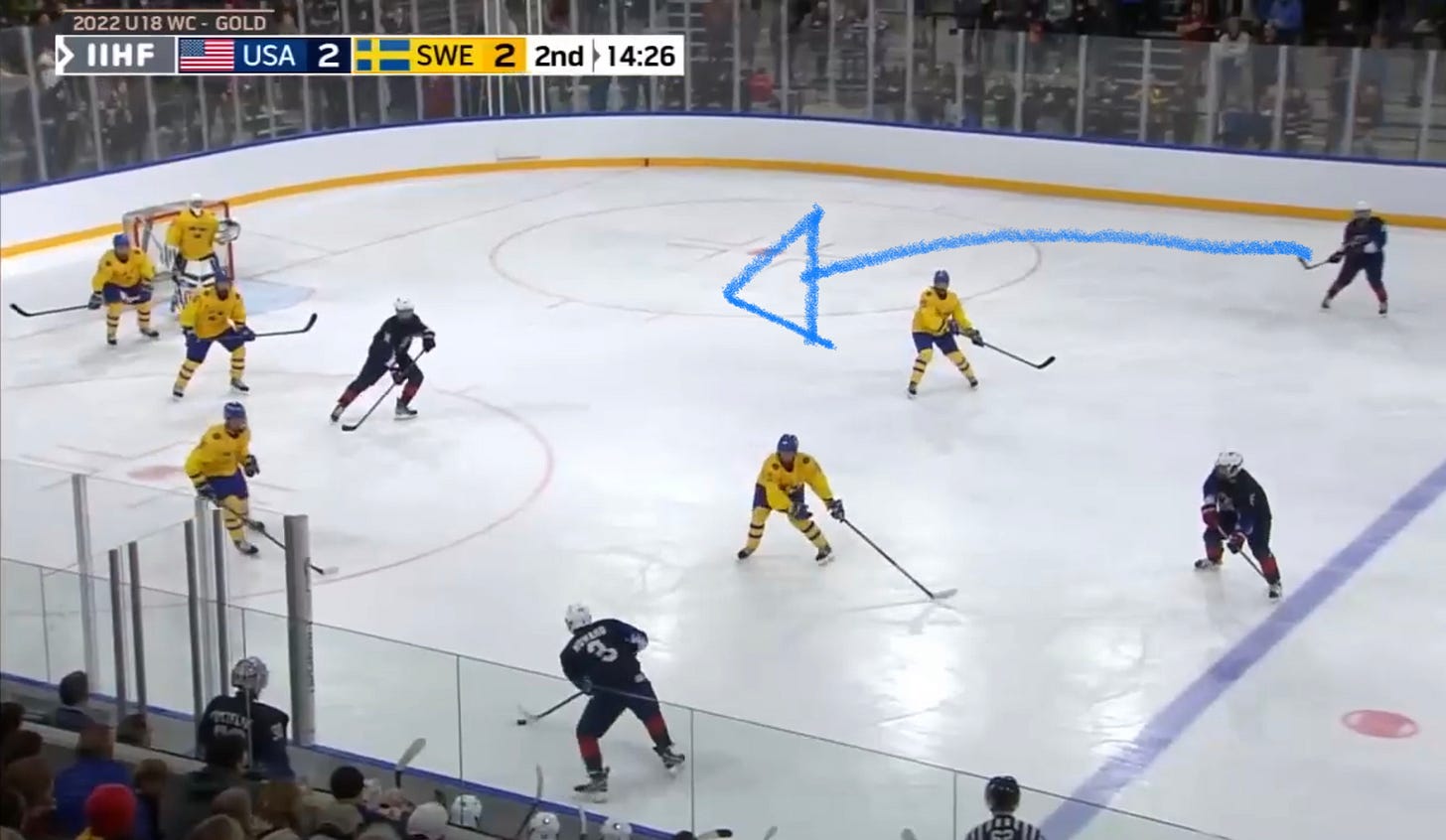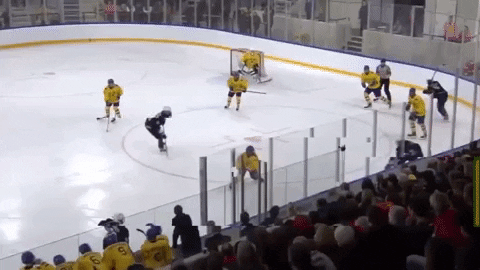First, we’ve established that point shots suck. Second, we are people that go beyond complaining and actively look for solutions.
Alright, now into how we can better play the point. In a really cool turn of events, we were able to connect with Casey to get further detail on his point play.
“So much offense can be created from up there” - Casey
Seamus Casey
Seamus Casey (#26) is a 5’10” defenseman with the USNTDP. While undersized by NHL standards, Casey has excellent skills, maturity, and habits that should lead him to a long professional career.
While “undersized” and lacking elite speed, Casey has amazing edges and weight transfers within his movement. Add to boot that he has great scanning habits and you’ve got a great puck-moving defenseman (“The breakout king”). Just look at these edges in the U18 Gold medal game!
As you likely know by now, it’s not just about the assets players possess, but rather how they utilize those assets.
Scouting Report
For background, the USNTDP focused on spreading out the offensive zone and would often use the low to high pass and then a D-to-D pass.
One of the friends of the Hockey IQ newsletter, Austin Garrett of Smaht Scouting, keyed an area that is a place of concern in Casey’s game.
Given Seamus Casey’s skillset, it would seem that Casey would have no problem generating offense from the backend and that he would be a very aggressive and a puck-dominant force in transition.
However, Casey is surprisingly passive in the offensive zone and defers to passing, and not carrying, the puck in transition.
This passive play was likely a result of Casey's focus on ensuring he had a strong defensive game this past season.
In the offensive zone, Casey typically stays high at the blue line and will, occasionally, dive or scissor into the play when a forward comes up the wall on his side.
When he chooses to activate off the blue line is where Casey’s offensive game can take you out of your chair. He has an elite ability to be both deceptive and laterally explosive to beat an oncoming defender with his puck skill and footwork with his edges.
Simply put, we believe Casey has been leaving a ton on the table when he received the puck at the point. He often would get stuck in tight spots and send a “sifting shot” toward the net looking for a tip play.
Given his skill set, a lot of traditional “risks” are not really risks at all. He’s good enough to calculate and take more chances.
Active Point Play
The point is where the defensemen normally stand near the blueline.
It’s a terrible place to shoot from. The best offensive-producing defensemen like Zach Werenski find ways into more dangerous areas of the ice.
Point activation means being active from the point position and moving into higher threat positions. Often this means diving into the zone or a scissor movement with the forward skating high.
Inactive Point Play
The lack of movement can get him stuck in awkward positions where 1 opponent covers and wins battles against two USA players.
Instead, a likely read here could be:
Move to the middle, if the player stays on the wall or
Dive down into the zone in a scissor movement, if the player skating towards him moves slightly off the wall.
Casey mentioned that he had a high focus on his defensive game this past season and ensuring he was continuing to improve his defense. Here is a prime example of Casey shading towards defense.
Rather than lean towards defense, Casey can jump into these holes.
The Difference between the Next Play vs the Best Play
While a lot of the plays that Casey makes are solid next plays, his lack of movement within pass reception often leaves the best play still on the table.
In the below clip, Casey’s minimal movement allows the defense to get in the shooting lane and close off his space. Looking closer, you can even see the weakside defensive winger being able to start out towards his defensive partner.
Casey misses the opportunity to pull the puck and skate into the middle ice (also called walking the blue line). This would make it very difficult on the defenders and keep them honest (read the weakside winger couldn’t cheat out toward his defensive partner).
This can often be a difficult conversation or one that isn’t had at all with players. Why? Because the next play is still good. But you as a reader of the Hockey IQ newsletter know… it’s not just about the next play, it’s about the best play.
Details at The Point
Movement away from where the puck is coming from is powerful. Let’s look at two examples.
One where he ends up stuck due to lack of movement and poor starting position. This is a common mistake where players start in wide-open spaces because they feel most open and comfortable.
On the other hand, we can see when Casey starts narrower inside the dots and gains movement before his puck touch. He is able to beat the opposing winger and cause defensive havoc before passing to a now wide-open teammate for a great scoring look.
Simply starting within the dots is a great way to use ice geography.
Shorting the Zone
Shorting the zone is the concept of starting lower in the zone. This often means making the top of the circles the new starting point. This is great for defense as it creates great gap control. This is also great for point activation and movement since there is more room to use.
“I like to gap down on the strong side then pull back to add to the offense. Aka. Shadow” - Casey
Here is a perfect example of shorting the zone and leaving space to move into later. Cale Makar can’t do this by sitting back on the blueline waiting around.
Here is Casey with the same technique. Highly effective.
Bringing it Together
Details enable skills to become utilized effectively. In this case, a little movement goes a long way to opening up Casey’s and team USA’s offense.
Moving into the puck or moving away changes the angle and allows for rolling of speed. Some players move through their pass receptions but with their heads down. Others keep their head up but only move after receiving the puck. Many players (even top prospects & NHLers) usually do one at a time. The most effective do both at the same time to great effect.
To summarize:
Movement within the pass reception, either into the puck or away from the puck
Head up to read the incoming defender’s angle + feet and what is available offensively
Position well to save space for future use in order to attack space via feet and passing
Bonus - One of the other areas we talked about with Casey was his activation in the rush offense. One area he highlighted was making sure he was getting even with the puck in order to get into the rush.
We followed up with Seamus Casey and saw improvements in his point play, check out that in part 2.
Further Reading
Puck Acquisition habits are critical to player’s having consistent play
The most important speed in hockey, Processing speed. And how to develop it.
Did you enjoy this newsletter?
Help us spread the ideas within and share it with the people you care about












